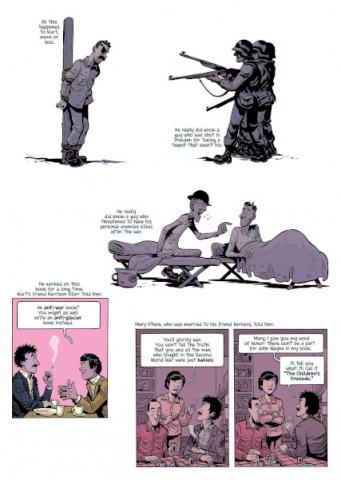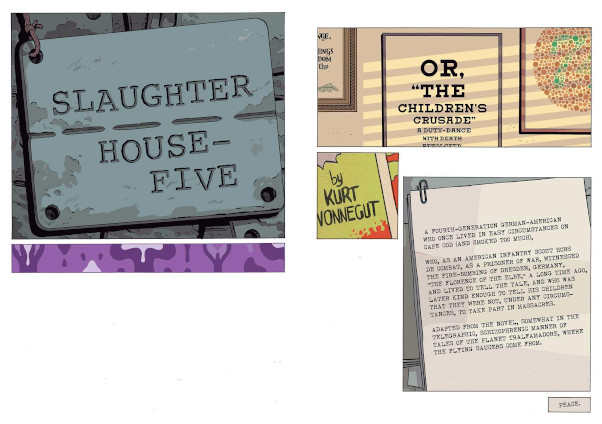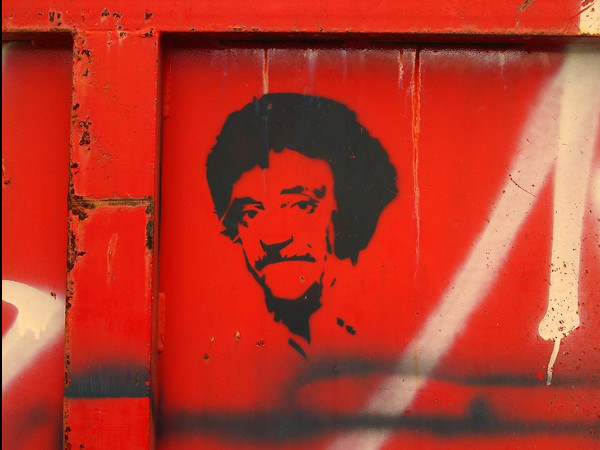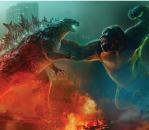New Graphic Novel Pays Homage to a Kurt Vonnegut Classic

Sequels, re-imaginings, and remakes. Rarely do these works live up to their original counterparts. After all, it's hard to follow up any piece of media, let alone wildly successful ones that become cemented in pop culture and widely celebrated as classics.
Everyone has their own idea of what should happen next, what shouldn’t, whether anything should even happen at all. It’s even tricky to reiterate a classic work out of reverence to its creators. Damned be the bands that try to cover “Bohemian Rhapsody.”
However, with enough love and appreciation for the original work, anyone can find a few kids belting out Queen’s magnum opus a bit of fun even if their lead singer has nowhere near the technical proficiency of Freddie Mercury. This would be the best metaphor to describe Ryan North and Albert Monteys’ graphic novel adaptation of Kurt Vonnegut’s classic dark comedy Slaughterhouse-Five.
While this graphic novel adaptation is unable to stand up to the original work, I think it would be foolish to expect as much. Nor does the adaptation convey that these were North and Monteys’ intentions.

Slaughterhouse-Five: The Graphic Novel is a faithful retelling of the story of Billy Pilgrim and his journey through time. While it covers the entirety of the book verbatim, the authors still add their own twist to it, giving the adaptation a bit of original charm, and showing deference to Vonnegut and the original novel in its presentation.
One of the biggest challenges in adapting a novel like this is that much of the content comes from Vonnegut’s comic descriptions. With graphic novels serving as a more visual medium, and the text that is presented often being reserved for dialogue, preserving the wit of the original work is a challenge the authors contend with well -- including a lot of the best and most important text in the panels.
The greatest achievement this adaptation brings is its inclusion of Vonnegut’s tendency to break into the story, to point things out as himself. For example, Vonnegut occasionally points out background characters as himself. This is executed nicely with little arrows pointing to characters with text attached saying, “This was Kurt.”
In fact the entire opening to the original novel is Vonnegut talking about his process of writing the book. He narrates his meeting with an old war buddy and the belabored process of trying to find the words to describe a tragedy such as the bombing of Dresden, the event on which this book is centered.

The adaptation translates this perfectly, instead of treating us to panels showing the things Vonnegut describes, the authors instead do what Vonnegut did and tell us a bit about the creation of the original work.
Part of what makes the execution of this graphic novel so brilliant is that the authors do not pretend to write as Vonnegut, but narrate this portion as themselves, similarly to how Vonnegut narrates Billy Pilgrim’s story. This is a charming allusion to the original work that keeps the tone of the original intact.
The graphic novel also alters details slightly to add its own unique comic edge. For example, Kilgore Trout, an unsuccessful science-fiction writer in the fiction of the novel, is made to be a comic writer, with the authors making a self-deprecatory remark through a character who questions if Kilgore Trout could stoop any lower.
Kilgore Trout's novels are also adapted and shown to the reader as a classic comic book. Whereas in the original book, Vonnegut describes the plot of the book, the adaptation creates an actual comic out of what is described. The aesthetic of the graphic novel is completely shifted to that of a classic 1950s comic book -- with the pages holding the sepia tone and “Ben-Day” dots used in classic comics.

Overall, the art style has a cartoony feel reminiscent of older comic books. There aren’t the tough angular superheroes found in the pages of Marvel and DC comics. However, this is exactly as it should be. After all, Vonnegut writes himself as saying “there won't be a part for Frank Sinatra or John Wayne” in his novel.
North and Monteys hit the mark precisely in adapting their own brilliant version of Slaughterhouse-Five. The graphic novel recreates the tone, theme, and bizarre nature of the original work and is ultimately a love letter to Vonnegut’s classic.
Why then does it not match up to the original? Simply because it would be impossible to do so. When a literary work is built on clever writing as Slaughterhouse-Five is, to take away any of it detracts from the experience.
This is not to say this adaptation is bad. This is about as perfect of a recreation as I could imagine. It stays faithful to the original while adding its own notes of originality and charm. It is a fun read for those who love the novel and something a little different for fans of graphic novels, where superheroes and action adventure reign supreme.
Author Bio:
Garrett Hartman is a contributing writer at Highbrow Magazine. He is a California State University, Chico, student double-majoring in media arts design technology and Journalism/PR. A lover of pop culture, Garret enjoys a wide array of film, television, video games, and literature. However, as a drummer in a rock band and an alt-rock enthusiast, music holds a special place in his heart.
For Highbrow Magazine
Image Sources:
R (Flickr, Creative Commons)
Archaia































































































































































































































































































































